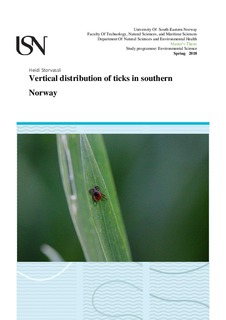Vertical distribution of ticks in southern Norway
| dc.contributor.author | Storvassli, Heidi | |
| dc.coverage.spatial | Norway | nb_NO |
| dc.date.accessioned | 2018-12-13T13:58:53Z | |
| dc.date.available | 2018-12-13T13:58:53Z | |
| dc.date.issued | 2018 | |
| dc.identifier.uri | http://hdl.handle.net/11250/2577634 | |
| dc.description.abstract | Due to climatic changes, plant and animal species have expanded their range vertically. One might therefore expect to find species at a higher elevation point than usual. By using both live and lethal traps, small mammals was collected in the field for three separate months along two transect lines to estimate tick burden and density. The method used is easier and less weather dependent than flagging. There was a strong effect among tick density and elevation, species, season and area. No correlation was detected for temperature or humidity. One can conclude that ticks may be found in the mountain region, preferably in a higher abundance in the coastal region in Lærdal, than the inland region in Bø, but that they do still have an altitude limit, and that it is season dependent. | nb_NO |
| dc.language.iso | eng | nb_NO |
| dc.publisher | University of Southeast Norway | nb_NO |
| dc.subject | ticks | nb_NO |
| dc.subject | tick distribution | nb_NO |
| dc.subject | climate change | nb_NO |
| dc.subject | range expansion | nb_NO |
| dc.title | Vertical distribution of ticks in southern Norway | nb_NO |
| dc.type | Master thesis | nb_NO |
| dc.description.version | publishedVersion | nb_NO |
| dc.rights.holder | Copyright The Author | nb_NO |
| dc.subject.nsi | VDP::Matematikk og Naturvitenskap: 400::Zoologiske og botaniske fag: 480::Økologi: 488 | nb_NO |
| dc.subject.nsi | VDP::Matematikk og Naturvitenskap: 400::Zoologiske og botaniske fag: 480 | nb_NO |
